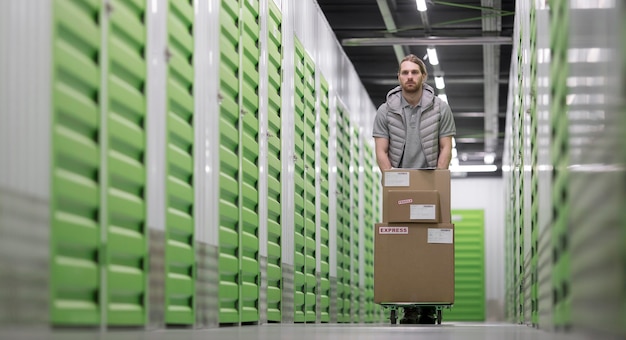
Want to learn how to invest in self-storage?
I’ve stored my stuff in boxes plenty of times over the years, and there’s a good chance you have too, or at least know someone who has. Investing in self-storage facilities can be a relatively low-risk way to diversify your income streams. It might even be a full-time business opportunity for you!
So, what exactly is investing in self-storage? It’s when you put your money into self-storage facilities and rent out units to people. I’ve used self-storage for various reasons over the years, and every time, I think about how profitable and passive it seems to be an owner or investor. There are usually no customers around when I’m there, but every unit is rented. It seems like an easy way to make money without much work!
Plus, over 9% of households pay for self-storage units, and there’s a high demand for new facilities.
Quick Summary:
– Self-storage investing can generate income and run a business with low expenses.
– There’s a high demand for storage units, with many businesses having long waitlists.
– If you don’t want to run a business, you can buy shares in a REIT or rent out your garage or basement.
What is Self-Storage Investing?
Simply put, self-storage investing is when you invest in storage facilities. More people need storage units for various reasons like moving, downsizing, storing items they don’t have room for (like an RV or boat), or businesses storing extra inventory. For example, someone might need a short-term lease to store belongings while moving between homes.
If you decide to invest, you have a few options: you can buy and own a facility yourself or passively invest by buying shares in a self-storage REIT (Real Estate Investment Trust).
Is Self-Storage a Good Investment?
Yes, investing in storage units can be a good idea. According to Neighbor, the average profit margin on a self-storage unit is around 41%, with high occupancy levels of about 92%. One major benefit is earning income with less work since customers usually store their stuff and don’t visit often. Self-storage facilities typically have lower expenses compared to other commercial real estate investments and are often recession-resistant. Another benefit is the flexibility, as you don’t need many employees to run a storage lot. Some facilities don’t even have any employees on-site.
Types of Self-Storage Facilities for Investment:
1. **Climate-Controlled Storage**: Protects belongings from temperature changes and humidity. Ideal for items like electronics, artwork, or documents.
2. **Mixed-Use Storage**: Combines multiple types of storage units in one location, catering to different customer needs.
3. **RV and Vehicle Storage**: For storing RVs, valuable cars, and boats. High demand due to neighborhood restrictions on parking.
4. **Boat Storage**: Specializes in safe storage for boats during the off-season. Often has long waitlists.
5. **Drive-Up and Outdoor Storage**: Common type where customers can drive directly to their unit, making loading and unloading easier.
How to Invest in Self-Storage:
1. **Buy an Existing Self-Storage Facility**: Purchase a business from mom-and-pop operations. This saves time as everything is already in place, but it can be expensive upfront.
2. **Build a New Self-Storage Facility**: With high demand, building a new facility can be profitable. You’ll need to find land, build, and market your facility.
3. **Buy Shares in a Self-Storage REIT**: Invest in a portfolio of self-storage properties without owning or managing the facilities.
4. **Rent Your Space on Neighbor.com**: Rent out extra space in your home, like a garage or spare room, through a platform like Neighbor.
Advice for Managing a Self-Storage Facility:
– **Making Money**: Offer amenities like vehicle washing or electrical plugins to attract renters.
– **Security**: Ensure your facility has plenty of light, security cameras, and gated access to make customers feel safe.
Frequently Asked Questions About How To Invest In Self-Storage:
– **Finding a Business for Sale**: Search on websites like LoopNet and BizBuySell.
– **Best Self-Storage Stocks**: Popular stocks include Public Storage (PSA), Extra Space Storage (EXR), and CubeSmart (CUBE).
– **Best REITs**: Well-known REITs include Life Storage (LSI), National Storage Affiliates (NSA), and Simply Self Storage (SSS).
– **Risks**: Include competition, changes in demand, and natural disasters. Managing a facility requires time and possibly employees.
– **Profitability**: Depends on location, demand, and operating costs.
– **Passive Income**: Can be earned through rental fees but managing a facility requires work. Investing in REITs or stocks is more passive.
– **Recession Performance**: Historically, self-storage has done well during recessions as people need temporary storage.
The future for self-storage looks positive, with high demand and waitlists everywhere. Many facilities have high occupancy rates and can’t keep up with demand.
Summary:
If you’re looking to add a new asset class, investing in self-storage can provide stable cash flow and additional income. Factors like location, demand, and facility quality will impact your investment’s success.